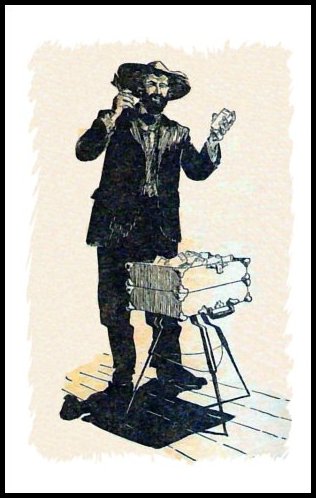Soapy, one of
the most infamous gangsters of the 1860’s. His infamous Prize Soap package
swindle took countless states by surprise and earned him the name Soapy Smith.
The techniques he used to persuade people into buying his soap bars were
brilliant and people still fall for them today. This is his story….
Soapy had a soap
stall. He wrapped each bar of soap with plain paper. Once in a while he would
wrap a bar of soap with some money (notes ranging from $1 - $100), then he
would cover the money with some more plain paper. The result was a pile of soap
bars, some with money and some without. Soapy then proceeded to sell the bars
auction-style, starting price at $1.
If this scenario
seems familiar it’s because the exact same principles operate in lotteries or
lucky-draws. So what exactly lures people into buying a few seconds
of irrational hope? Well it a combination of clever landscaping on the part of
Soapy, and the victim’s natural cognitive biases. By drawing a crowd Sopay was
able to create a ‘band wagon effect’ where everyone wants to be part of the
action (Nadeau, Cloutier & Guay, 1993).
‘Emotional contagion’ also plays a part as bidding begins and everyone gets
excited (Hatfield & Cacioppo, 1994).
But perhaps the most influential motivator is the belief that just because
somebody else won, they too have an equal chance of winning. This is known as
the Base rate Fallacy (Baron & Jonathan, 1994), where one tends
to ignore base rate information (the actual likelihood of winning) and focus on
specific information (the number of winners, but not the number of losers).
Of course once in a while someone had to win a bar of soap
otherwise people would suspect something was up. Unknown to his victims, the ‘soapy gang’ were in amongst the
crowd of buyers. Only members of the gang were fortunate enough to pick out
bars of soap containing cash and once they found the money inside, gang members
would celebrate loudly letting passers-by know exactly how they beat Soapy at his own game. This “friendly advice”
actually is yet another attempt at getting people to participate. The
accomplice makes it seem as though he and the victim are on the same side -
both trying to catch Soapy out. As the con progresses two additional techniques
are employed. As more soap bars are sold the competition for the remaining bars
increases. This introduces the scarcity principle, where people want what is
fast becoming unavailable (Lynn, 1991). Finally the perception of a time limit,
created by the auction-style of selling makes people more impulsive and willing
to participate (Klein, 1998).
Numerous casinos
and lottery games worldwide employ these simple yet effective techniques. So the
next time you want to try your hand at a gamble, think twice because the odds
of you winning really are as slippery as soap!
References:
Baron, J. (2000). Thinking and deciding. Cambridge University Press.
Brickman, P., Coates, D., & Janoff-Bulman,
R. (1978). Lottery winners and accident victims: Is happiness relative?. Journal of
personality and social psychology, 36(8), 917.
Griffiths, M., & Wood, R. (2001). The
psychology of lottery gambling.International
gambling studies, 1(1), 27-45.
Hatfield, E., & Cacioppo, J. T. (1994). Emotional
contagion. Cambridge university press.
Klein, G. A. (1998). Sources of power:
How people make decisions. MIT press.
Lynn, M. (1991). Scarcity effects on value: A
quantitative review of the commodity theory literature. Psychology &
Marketing, 8(1), 43-57.
Nadeau, R., Cloutier, E., & Guay, J. H.
(1993). New evidence about the existence of a bandwagon effect in the opinion
formation process. International
Political Science Review, 14(2), 203-213.
Rogers, P. (1998). The cognitive psychology of
lottery gambling: A theoretical review. Journal of Gambling Studies, 14(2), 111-134.
Wood, R. T., & Griffiths, M. D. (1998). The
acquisition, development and maintenance of lottery and scratchcard gambling in
adolescence. Journal of
Adolescence, 21(3), 265-273.
Learn more about
soapy and the many cons he created:
http://www.soapysmith.net/id16.html


No comments:
Post a Comment
Note: Only a member of this blog may post a comment.